AI Story Turbines: Prime Instruments and Ethics for AI Assisted Fiction
Have you seen the social media buzz about AI story generators and other artificial intelligence writing software like ChatGPT? The breakthroughs in AI have prompted a discussion about how we write and the ethics of AI-assisted writing. At the same time, there are also real-world uses AI software, including generating story ideas to research papers to writing full-length novels?
Can AI help writers craft compelling stories? And what is the ethical line for its use?
Today we have a guest post from Navkiran Singh, a writer and software engineer who taught his teenage sister how to use AI story generator tools to help her craft her own stories. Take a look and see how artificial intelligence might enhance your own writing practice. Welcome, Nav!
My 14-year-old sister wanted to write stories like the ones she read in her school books. The characters and the plots in her head felt so vivid to her. But when she sat down to write, she wasn’t finding the right words! (English is not our native language)
I didn’t want her to stop writing. However, as a software engineer, I didn’t know much about story elements or writing fiction.
I did know about tech.
I shortlisted some AI tools focused on fiction writing and taught her how to use one of these AI tools to brainstorm the characters and flesh out the story plot points she had in her head.
With the help of AI, she has finally found the polish she wanted her words to have and has now published two short creative stories on her personal blog.
In this article, I want to share the writing tools I found and how they can help writers. Primarily, I will be talking about Sudowrite because that is the one I shared with my sister. (I discovered Sudowrite through a blog post by Joanna Penn, a NY Times best-selling author).
“
Can AI help writers craft compelling stories? Read one writer’s experience with AI story generators in today’s article.
What are AI Story Generators?
AI stands for artificial intelligence (trying to make computers that think like humans). Just like we learn about a topic by reading dozens of articles, AI story generators are taught what a story should look like, by giving them millions of rows of data as input.
The AI may then develop new stories much like a person would by using the information it has learned. The input given to such AIs is called a prompt.
AI-based story generators can be used in a wide variety of ways, from writing original stories (based on a human directed prompt) to building a story outline or characterization description. It all depends on the goals of the user.
Top AI Story Writing Tools
There are a number of story generator tools out there. My criteria for shortlisting an AI story tool included:
- a focus on story writing features
- ideally recommended by an author
- high monthly word limit
- low cost
I reasoned that an AI focused on story writing would have been trained on better datasets with so many stories and styles of writing to draw from.
I emphasized having a high word limit for a low price because story writing requires spending a lot of words on brainstorming. You don’t want to run out of your monthly plan word count limit without producing a lot of usable content.
Below, I’ve listed a few of the tools I thought would work best to help my sister or other writers get their stories down while expanding their experiences in writing.
Free tools:
- Plot Generator. Generate story ideas, short stories, fairytales, plot twists, and more.
- Sassbook Story Writer. Write stories in different genres like classic, humor, science fiction, romance, etc.
Paid tools:
- Sudowrite. Budget-friendly, free 4000-word trial. (Features explored below)
- Novel AI.Best for writing novels. It can rewrite plots, replicate famous writers, and even generate images for your story. It learns from your own writing to imitate your style.
- Rytr. Affordable plans and it has writing styles and options in addition to story writing such as writing product descriptions, blog sections, e-mails, and other types of content.
- Jasper AI. Expensive, but best at generating book blurbs, story hooks, and cliffhangers. Leading AI tool for copywriting. I recommend it for the sales aspect of writing such as catchy titles, summaries, and ads.
Honorable mention: AI Dungeon – Not a writing assistant but a text adventure generator. Best for those who want to have a little fun not only creating storylines but playing them as a character.
How AI Can Help Writers
AI story generators can help writers brainstorm ideas, expand plots, describe things in their stories, and even come up with interesting twists. An AI writing assistant can even be a novel method to overcome your writer’s block.
Let’s use a rough draft that my sister wrote. I will explain key features that can help writers by using her words as a prompt. Note, AI generates a different every time it runs, so even I don’t know what story I’ll get at the end!
Brainstorm
Sudowrite gives you the option to brainstorm characters, plot points, worlds, places, and more. It can help you develop more story choices based on whatever elements are most important to you or your story.
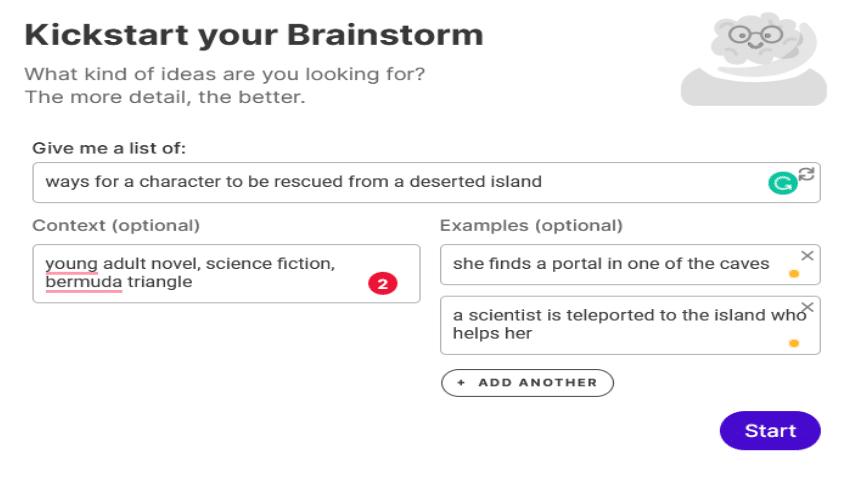
For example, let’s brainstorm ways to rescue a character from a deserted island. You will have to give 2-3 examples of what you consider to be good ideas and the AI will generate more ideas for you. While brainstorming characters, you only need to give a 1 sentence description.
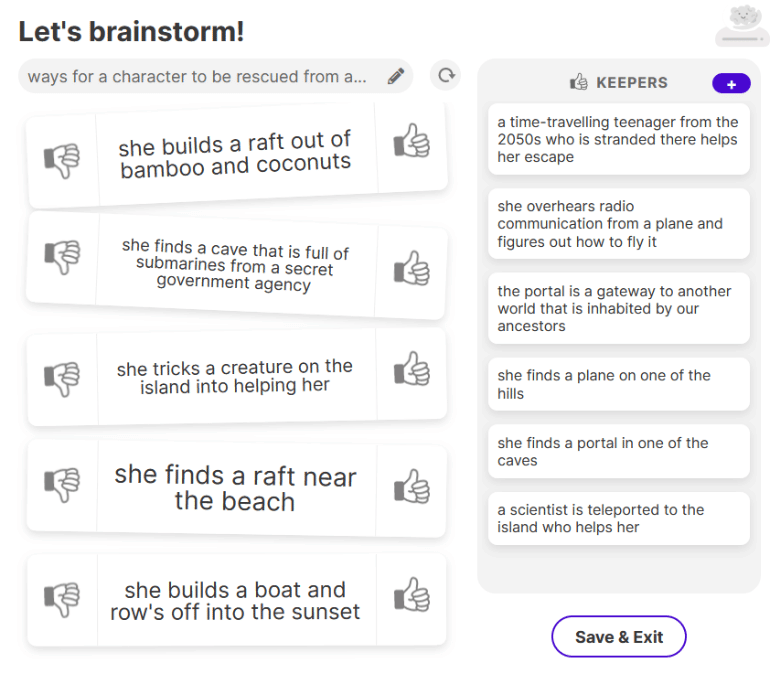
All of these ideas were generated by AI. You can save the ideas on the right. If give an idea a thumbs down, it will generate new ideas. A thumbs up leads to suggestions for similar ideas.
The idea of a time travelling teenager from the 2050s looks promising. Maybe these two teens from different timelines can work together to get back to their respective homes.
Improve Description
Do you find it hard to write evocative descriptions for important items in your story? Most fiction writers are good at describing people, places, or things in terms of how they look (sight) or how they sound, but you might neglect other senses.
For the reader to live your story, it is important to capture all of his/her senses and not just sight or sound.
Sudowrite can generate descriptions in terms of:
- Sight
- Sound
- Smell
- Touch
- Taste
- Metaphors
For example, describing “my copy of Great Expectations in my bag” gives me results such as:
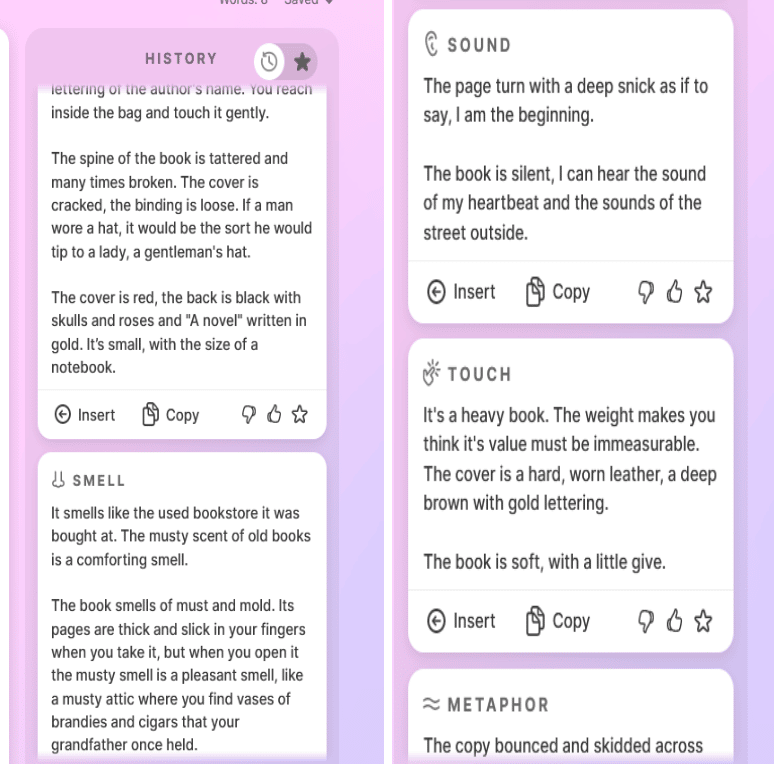
I will still want to improve these descriptions and make decisions about which details best serve my story, but they are a good start.
In my sister’s rough draft, the suggestions describing the Bermuda triangle are mediocre here, probably because the AI did not have a lot of data on the Bermuda triangle. My sister could do additional research or draw from her own imagination to embellish here.
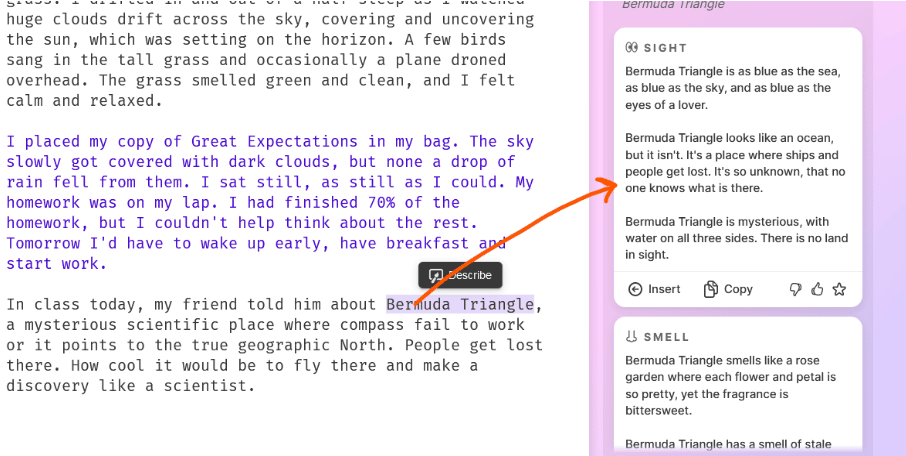
Rewrite
Sometimes you might feel that your words are not painting a clear picture or require a little polish. Maybe the story could use a different perspective Perhaps you are telling not showing (like I am doing right now).
Sudowrite’s rewrite feature allows you to:
- Rephrase text
- Shorten text
- Expand text
- Mimic a famous style
- Add more inner conflict
- Show not tell
The snapshot below is show-not-tell feature in action. The left side is my sister’s initial draft. It is very rough and has a lot of grammatical errors. It’s hard for the reader to visualize what’s happening. But the right side establishes a much better visual picture of the scene. It shows rather than tells.
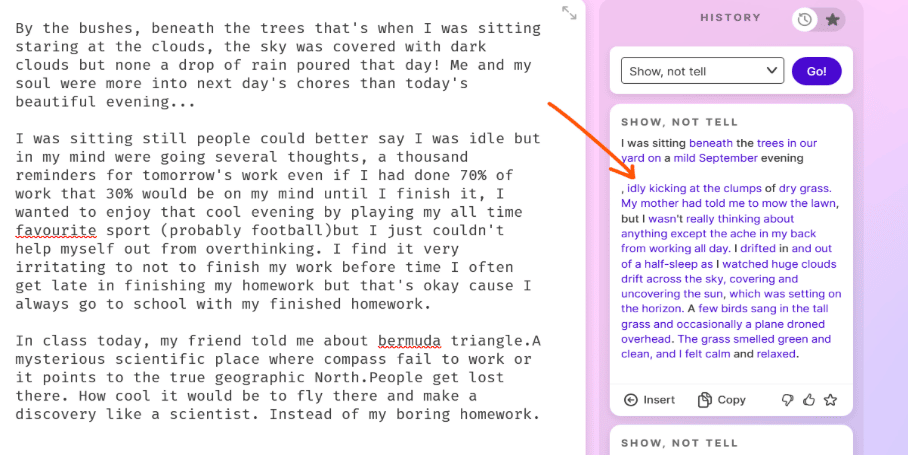
Sudowrite gave multiple results for show and tell. You can insert any of the suggestions you like and edit them to better reflect the story you’re telling. I tried out the shorten feature to make one paragraph shorter, and the expand feature to lengthen the ending of the scene with pretty good results.
I began with a collection of haphazard thoughts, and we now seem to have the first scene of a pretty decent story. It’s started the creative juices flowing.
I’m thinking the story could become a Robinson Crusoe type adventure—surviving a deserted island and finding the way back home. A mix of sci-fi (there could be more portals) and survival genre.
Insert a Twist
Another feature is twist generation. If you provide a summary to Sudowrite, it will give us several possible twists for the story. Currently, this feature works with sci-fi genre only and is an experimental feature.
Here’s the summary I gave:
Jot is sitting underneath a tree. It is a cloudy evening but it has not rained yet. She is procrastinating on her homework and thinking about what her classmate told her about the Bermuda Triangle. Suddenly a bright light appears and she is transported to an island.
Here’s one of the twists AI suggested:

I would still need to write the twist into scenes, but again, it has given me some ideas that I didn’t have when I started.
My Evaluation
Sudowrite gave a pretty good starting point for a story with very little work on our part. Output is mostly coherent, and there are multiple results to choose from. It’s a good tool to support your writing practice—not replace it.
Sometimes the AI produces weird results like in the case of describing the Bermuda triangle as “blue as a lover’s eyes.” This is probably due to less data being available on that particular term.
At times, the story generated by AI feels procedural and lacks depth, but that’s where your writing skills and unique point of view are absolutely still needed to produce truly high-quality content and storytelling.
AI and Ethics
With any new technology, ethical concerns are bound to arise. The use of AI for creative tasks is full of ethical debates and questions like these:
Is AI-generated content plagiarized?
AIs don’t copy text from multiple sources. AI learns relationships between the text, as a human would, and generates new text, every time you run it. Because AI-generated content is not copied, it is unlikely to trigger a plagiarism detector. I still advise using plagiarism checkers.
However, Google does consider autogenerated content spam (even though they don’t seem to have a way to detect it yet). Given that Google uses AI in a lot of its products itself including search, will it re-evaluate this stance? Who knows.
This field is rapidly developing and we’re likely to see Google and other companies try a variety of tools to see how to best detect and produce better content for users.
Is AI-generated content copyrighted?
Most companies making AI writing tools don’t claim copyright on the content generated by users with their AI. For example, Sudowrite does not claim copyright on the content generated through the use of their tool. They do strongly recommend using it as a draft to inspire you not as your final work.
I’d still advise double-checking the terms and conditions of the software you are using, to be sure.
Should writers explicitly mention they used AI in their works?
Joanne Penn likens Sudowrite to an extended thesaurus. Sudowrite co-founder Amit Gupta says that at some point, it’d be a natural part of the writing process, like spellchecking software which is not expected to be mentioned.
However, I think it is more appropriate to clearly mention the use of AI, especially when using AI content directly without modification. Publishers don’t seem to have any particular guidelines on this yet, and we’ll see if AI-generated stories become a separate market, or if they are only used as models for human writers to build from individually.
Way Forward
As a software engineer who also likes to write, I envision a shared future where human creatives will use AI tools as a helping hand. AI is touching every creative field—be it stories, art, music, or even film.
A new era of creative thinking is inevitable and we can choose to be techno-optimists rather than pessimists. We already learn from famous writers, surely we can glean something useful from AI trained on their works?
It’s easy to condemn every new iteration of technology as polluting or weakening creative writing, but those types of scares are as old as the written word.
Writer Douglas Adams once observed that technology that existed when we’re born feels “normal,” and any new additions are met with suspicion.
While we need to be mindful of the ethics of anything we create using new tech, we can use these AI tools to enhance our process, play with writing styles, and ultimately help us bring stories to life that might otherwise go unwritten—like my sister’s stories.
“
While we need to be mindful of the ethics of anything we create using new tech, we can use these AI tools to enhance our process, play with writing styles, and ultimately help us bring stories to life that might otherwise go unwritten.
For me, stories have always been more about introspection rather than a description of events, and stories will always stem from the personal experiences of the writer,. In that sense, AI can’t replace a real human writing their truth.
What do you think? What questions do you have about AI storytelling tools and programs? Let us know in the comments.
Navkiran Singh is the friendly nerd behind NerdyNav.com, a software review blog. If you found the article useful, please drop by and say hello! You can also read his reviews of different AI tools with videos of him using them here.
Practice
Use one of the AI tools above to brainstorm either a new idea or to develop an idea that you’ve been thinking about for some time.
Set a timer for 15 minutes and use the tool to help you get started on an idea, character, or scene. Share the results (whether coherent or wacky!). If you’re a Write Practice Pro member, share your practice here in the practice workshop. If you post, make sure to comment on a few other writer’s works.
Not a member yet? Find out how to join our community today here and come practice with us.
